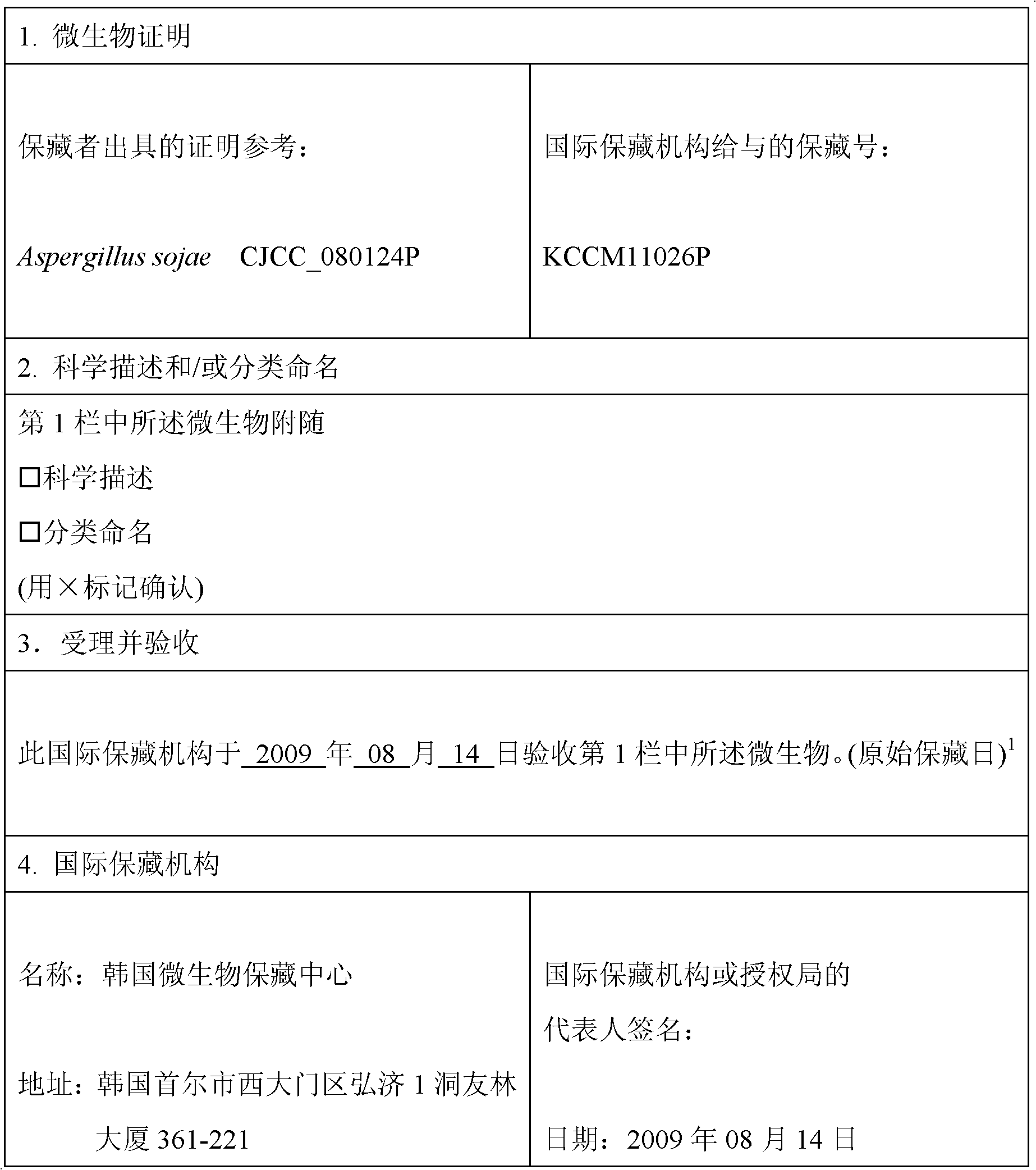Mutant strain of aspergillus sojae with enhanced protease activity and preparation method of natural taste enhanced using the same
A technology of protease activity and Aspergillus sojae, which is applied in the field of Aspergillus sojae mutant strains, can solve the problems of low activity level and so on
- Summary
- Abstract
- Description
- Claims
- Application Information
AI Technical Summary
Problems solved by technology
Method used
Image
Examples
Embodiment 1
[0027] Example 1: Isolation and selection of bacterial strains
[0028] Serially dilute 5 g of each sample, such as fermented soybean pieces, soybean paste (traditional bean paste), soy sauce, etc. collected from all over the country; add 0.1% Tween 80; then apply the diluted sample to On minimal agar plates (Charlotte agar) containing 0.1% Triton X-100. It was cultured at 30° C. for 3 to 4 days, and then a strain having a large clear zone around the colony was isolated.
[0029] The isolated strains were inoculated again in a minimal liquid medium (Chasse Broth; 0.3% NaNO 3 , 0.1%K 2 HPO 4 , 0.05% MgSO 4 .7H 2 O, 0.05% KCl, 0.001% FeSO 4 .7H 2 O, 3% sucrose), and then cultivated at 30°C for 3 days to 4 days. Cells were removed by centrifugation, the supernatant was collected, and then the proteolytic capacity was determined and compared by using casein as a substrate.
[0030] Among the strains, a strain with excellent proteolytic ability was selected, inoculated on...
Embodiment 2
[0032] Embodiment 2: the improvement of aspergillus sojae bacterial strain
[0033] (1) NTG mutagenesis
[0034] The above-mentioned Aspergillus sojae CJCC_011057P (KCCM 11043P) was cultured on a PDA slant medium to obtain a spore suspension. A 3 mg / ml solution of N-methyl-N'-nitroso-N-nitrosoguanidine (NTG) was mixed with an equal amount of the spore suspension, followed by incubation at 30°C for 1 hour.
[0035] The spore suspension was spread on PDA medium to select surviving colonies, and then the selected surviving colonies were cultured on PDA slant medium, and cultured at 30° C. for 4 to 7 days. At least 1,000 mutants were selected, and then cultured at 30°C in a liquid medium (3% defatted soybean, 0.5% KH 2 PO 4 , 1.5% yeast extract, 1.5% glucose, 0.05% magnesium sulfate) for 48 hours to measure protease activity. According to the results of protease activity determination, the strains with high activity were selected, and then the mutations of the strains were con...
Embodiment 3
[0038] Embodiment 3: measure the protease activity of the mutant strain that washes and selects
[0039] Protease activity was determined using casein as a substrate according to the method of Anson-Hagihara (B. Hagihara et al., 1958, J. Biochem. 45 (1958), 185-94).
[0040] Mix 400 μl of 0.75% casein solution and 100 μl of 0.24M Na 2 HPO 4 The solution (pH 7.5) was preincubated at 37°C for 5 minutes, and 100 µl of the culture solution of each selected mutant strain was added; then incubated at 37°C for 10 minutes. 600 μl of a mixture solution mixed with equal amounts of (1) 0.1M TCA (2) 0.22M sodium acetate and (3) 0.33M acetic acid was added to stop the reaction. 200 μl of the supernatant of the reaction solution was added to 500 μl of 0.55 M sodium carbonate solution, and then 100 to 500 μl of a commercially available phenol reagent diluted twice was added, followed by stirring. Thereafter, it was incubated at 30° C. for 30 minutes, and the absorbance was measured at 6...
PUM
 Login to View More
Login to View More Abstract
Description
Claims
Application Information
 Login to View More
Login to View More - R&D
- Intellectual Property
- Life Sciences
- Materials
- Tech Scout
- Unparalleled Data Quality
- Higher Quality Content
- 60% Fewer Hallucinations
Browse by: Latest US Patents, China's latest patents, Technical Efficacy Thesaurus, Application Domain, Technology Topic, Popular Technical Reports.
© 2025 PatSnap. All rights reserved.Legal|Privacy policy|Modern Slavery Act Transparency Statement|Sitemap|About US| Contact US: help@patsnap.com



